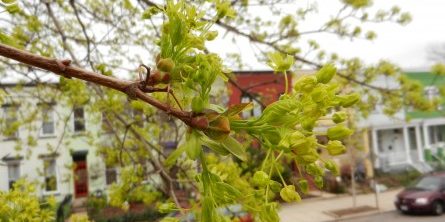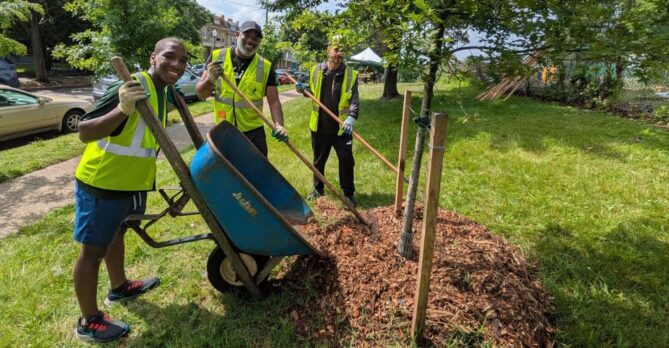
co-written by Stephanie Juchs & Dr. Jessica Sanders
It’s a story all too common in American cities. A tree imported from elsewhere seems to take the rigors of urban life well, cities sing its praises and plant it widely, then said tree gets a little too comfortable and starts out-competing native species and cities have to declare the species invasive.
The tale of the Norway maple, Acer platanoides, is not much different than other non-native species that have come before or since. Once revered as the ultimate street tree that could withstand the abuses of the urban environment and quickly grew and shaded many of America’s city streets that lost their canopy to Dutch elm disease in the middle of the 20th century, the Norway maple is now classified by the United States Forest Service as highly invasive in our region.
Native to much of Europe, from Norway to the Caucasus region as well as western Asia, the Norway maple is now found throughout the northeast United States and the pacific northwest. Introduced in 1756 by botanist John Bartram he received seedlings from London then promptly went about selling the successful species (even supplying two Norway maples to George Washington to be planted at Mount Vernon in 1772). The early success of the Norway maple led to the creation of numerous cultivars to fit both aesthetic and biological challenges. With the need for fast-growing shade trees when Dutch elm disease decimated cities’ tree canopies during the 1930s and 1940s, the Norway maple and its various cultivars grew to become (what some estimate) the most frequently planted and occurring street tree in the United States. Now in many eastern cities, the “Crimson King” cultivar’s purple-red leaves or the “Parkway” cultivar ‘s resistance to verticillium wilt, in addition to many others, provide the shade for many city blocks.
Fast-growing Norway maples quickly form a dense canopy and tolerate many adverse conditions which made them successful in cities as well as potential invaders. Norway maples can withstand a variety of environments and tolerate high winds, frost and air pollution, as well as a wide range of soil acidity. They cope well with the typical street tree environment which can include heat, drought, salt spray and poor drainage. Prolific seed production and shallow surface roots also allow the Norway maple to out-compete natives (which is why you’ll often see sparse vegetation in Norway maple tree boxes). However, the Norway maple’s tenacity and toughness does not make it immune to the serious threat posed to it and many other tree species by the Asian Longhorned Beetle. This non-native invasive pest prefers the maple genus as a host (along with several other genera) and doesn’t seem to discriminate against the native and non-native species found in the United States.

Even with its tolerance for urban life, the Norway maple was never a true substitute for its beloved look-alike, the native sugar maple. The sugar maple, which provides the primary source of maple syrup and the distinctive fall color seen in New England, should not be easily confused for its non-native counterpart. The interlacing furrowed bark of the Norway maple looks very different from the distinctive plated bark seen on the sugar maple and the samaras (or “helicopters,” as children often refer to them) on the non-native Norway maple are attached at a wide-angle with more flattened fruits when compared with the U-shaped attachment and bulkier fruits of the sugar maple. While both maples are oppositely arranged with 5-lobed leaves, the Norway maple has more distinct points and teeth than the sugar maple and it’s the leaves that provide the real clincher when trying to differentiate between the two. When squeezing the petiole (leaf stem) of a leaf, if milky white sap oozes out you’re looking at a Norway maple versus the sugar maple, which will exude a clear liquid, if anything at all. Both Norway maple and sugar maple are planted in D.C. and provide a good test for those testing their tree identification skills.

Filling a need for our canopy at the time when the District desperately needed it, the Norway maple was planted along many of Washington’s streets when Dutch elm disease swept through the city. However, time would show that their aggressive growing habits and prolific seeds would be undesirable and eventually classify them as an invasive plant. While the city stopped planting Norway maples more than 10 years ago, they still exist in the current canopy as seen on the map below. If we were to remove the city’s population of Norway maples today, we would decimate a large portion of the city’s canopy. Every year, Norway maples planted in between the curb and sidewalk are strategically removed and replanted with a more desirable non-invasive tree.
For D.C. residents, since the Norway maple is now recognized as posing an environmental threat, its removal does not require replacement under the District Urban Forest Preservation Act and the Norway maple is not eligible for any of our residential planting programs. For more information about invasive species that threaten the District’s tree canopy and how to control these species, consider attending one of our non-native invasive removal workshops held in the spring or summer.
